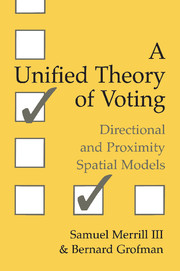Book contents
- Frontmatter
- Contents
- List of Tables and Figures
- Acknowledgments
- 1 Introduction
- Part I Models of Voter Behavior
- 2 Alternative Models of Issue Voting
- 3 A Unified Model of Issue Voting: Proximity, Direction, and Intensity
- 4 Comparing the Empirical Fit of the Directional and Proximity Models for Voter Utility Functions
- 5 Empirical Model Fitting Using the Unified Model: Voter Utility
- 6 Empirical Fitting of Probabilistic Models of Voter Choice in Two-Party Electorates
- 7 Empirical Fitting of Probabilistic Models of Voter Choice in Multiparty Electorates
- Part II Models of Party or Candidate Behavior and Strategy
- Postscript
- Appendices
- Glossary of Symbols
- References
- Index
2 - Alternative Models of Issue Voting
Published online by Cambridge University Press: 04 December 2009
- Frontmatter
- Contents
- List of Tables and Figures
- Acknowledgments
- 1 Introduction
- Part I Models of Voter Behavior
- 2 Alternative Models of Issue Voting
- 3 A Unified Model of Issue Voting: Proximity, Direction, and Intensity
- 4 Comparing the Empirical Fit of the Directional and Proximity Models for Voter Utility Functions
- 5 Empirical Model Fitting Using the Unified Model: Voter Utility
- 6 Empirical Fitting of Probabilistic Models of Voter Choice in Two-Party Electorates
- 7 Empirical Fitting of Probabilistic Models of Voter Choice in Multiparty Electorates
- Part II Models of Party or Candidate Behavior and Strategy
- Postscript
- Appendices
- Glossary of Symbols
- References
- Index
Summary
… [the voter] knows that no party will be able to do everything that it says it will do. Hence, he cannot merely compare platforms; instead he must estimate in his own mind what the parties would actually do were they in power.
Anthony Downs, An Economic Theory of Democracy (1957: 39)Proximity Models
The Downsian Proximity Model
To establish a baseline, we describe in some detail the classic Downsian proximity model. As in all spatial models, both voters and candidates are represented by points in a multidimensional space that reflect their opinions on issues; each issue corresponds to one dimension of the space. In the simplest case, there is only one issue (say, economic policy) and, hence, one dimension. At this level, the spatial model is no more than a formalization of the familiar left-right or liberal-to-conservative scale, represented by a line. By convention, numerical values on this scale increase from left to right. Other things being equal, it thus seems plausible that, say, a liberal voter on economic policy will prefer a candidate who is liberal on that issue to either a middle-of-the-road or conservative candidate and will prefer a moderate over a conservative. This suggests that the voter's evaluation, or utility, may be based on proximity in the spatial model, with highest utilities reserved for candidates located close by on the policy scale. This is the basic idea in the Downsian proximity model.
- Type
- Chapter
- Information
- A Unified Theory of VotingDirectional and Proximity Spatial Models, pp. 19 - 37Publisher: Cambridge University PressPrint publication year: 1999



